Copyright © 2007 - 2024, Coachworks For contact data Click Here.

Copyright © 2007 - 2024
Copyright © 2007 - 2024,
Coachworks For contact data
Click Here.

This engine has sold and remains documented here as an example of our work. Note that we always have parts on hand and can quickly build one like this for YOU. So, give us call or email us.
Note that when buying a long-block, you have options.

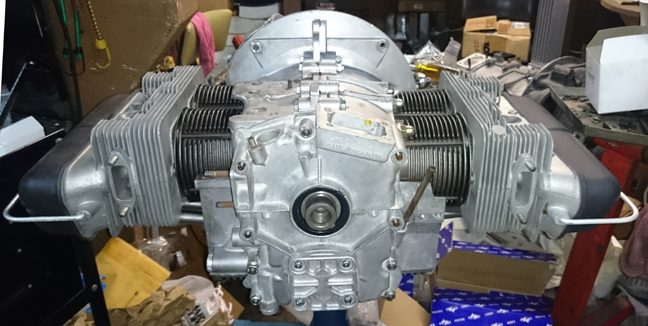
AT RIGHT: This engine as a completed long-block, as it was when we sold it. If you buy, have us complete it for you - see "purchase options" below for options we offer.
This 1966 Porsche 912 engine has just undergone a complete overhaul, and is fully balanced for smooth running, long life, and a few more HP. This page tells its story in 36 images!
This engine has many standard features we apply to all our engines - such a long list, we'd bore you here, but they're fully descrbied below. Skip over your purchase options to get deep into the detail!
BELOW RIGHT: This engine, as a long-block, ready to go! The text written on the oil cooler mounting flange informs that the engine is 1719 cc displacement and is set to 9.0:1 compression ratio. That's about 9% more displacement than stock with a slightly lower compression ratio to better tolerate today's fuels.
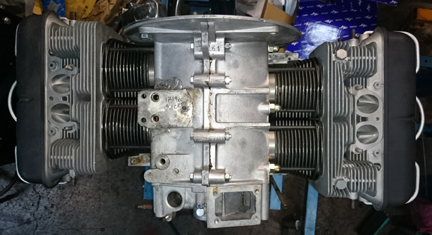 On
This Page
On
This PageClick here to skip options and get to the detail. Or, just scroll past and view the images!
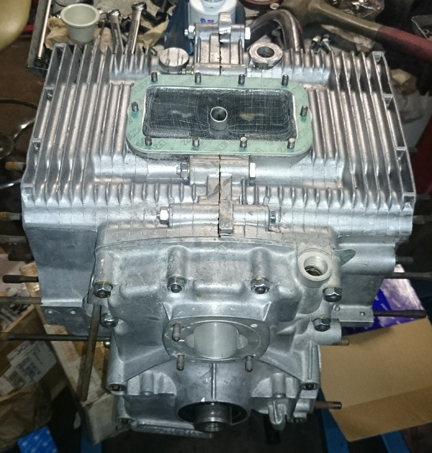 This
engine is being prepared in long-block form but may be purchased complete, ready
to install, and you have quite a few options. As there's a lot of material
here, and as prices do change with time, please contact us for pricing information.
This
engine is being prepared in long-block form but may be purchased complete, ready
to install, and you have quite a few options. As there's a lot of material
here, and as prices do change with time, please contact us for pricing information.
AT RIGHT: This engine is ALMOST to long-block form, with attention having turned to the sump screen, plate, drain plug, and oil control pistons. We ended up mounting the sump plate with aluminum sealing washers as they do a better job, and tall, stainless steel acorn nuts attaching them to the case as these protect the lower threads and help reduce the chances of a stud coming out of the case when a nut is removed.
(list continues below)
AT RIGHT: Here we have the rockers used in this engine ready for installation. They have been cleaned, and shafts polished, of course. Additionally, the tips which ride against the valve stems have been not just refaced but a new layer of metal has been added to help reduce wear. In the original, it was only surface hardened, and once worn through, the rockers won't keep adjustment - and keep shedding particles into the oil! However, this "hard-face" material is stronger than the original surface and is considered a permanent solution. There is a close-up photo further down.
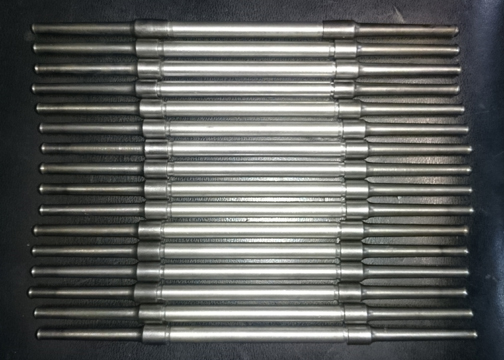 Background
on This Engine
Background
on This EngineThis 1966 engine came to us as an empty case and a few pieces. We gathered up what was missing and performed a complete overhaul, and is fully balanced for smooth running, long life, and a few more HP.
AT RIGHT: Two sets of pushrods, ready to go, one set of which went into this engine. Note that this type, with long steel ends and a short aluminum center, is for use with iron cylinders, like the NPR's fitted here.
This engine is type number 616/36 (912) and was originally constructed the summer of 1966. Of course this engine, as a 912 has all the features of a 912, often called "the late-type" in 356 circles, meaning that things like the oil pump, rockers, etc. are of the best (latest) design. This engine has undergone a thorough rebuild as described herein. Every detail about the engine has been attended to; nothing was ignored.
We received this engine among a group of cores bought at the Partsheaven swapmeet in the spring of 2015. Unfortunately, nothing further about this engine's past is known to us. However, during this rebuild it was fitted with new genuine NPR 86mm cylinders, it received new rod and main bearings, all new valve guides, its lifters and valve rockers were refaced, etc., and even the plating of small parts was attended to, such as the wire bails that retain the valve covers and air deflector plates, the nose bearing retaining bolt, the through bolt, and so forth. Nothing was overlooked.
This one was torn down LONG before we got it!
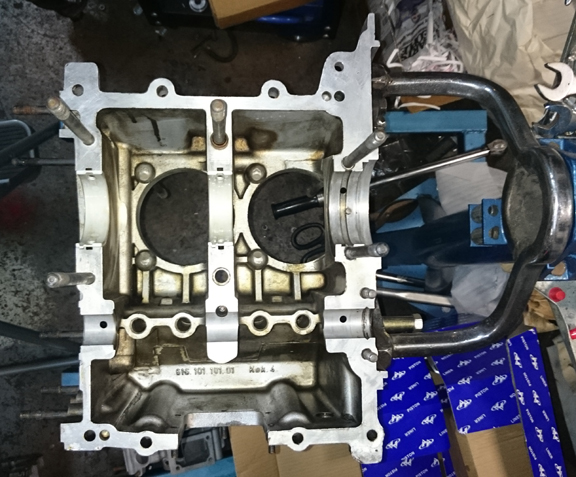 Crankcase Preparation
Crankcase Preparation This crankcase just needed a good cleaning and thorough inspection. One of the two M6 X 1.0 threaded bores for the forward pulley tin had a thread or two pulled, so that bore was more deeply threaded. (Always run the longest hex head bolts in these locations as will fit without bottoming out.)
As memory of the lifter bore problem with this engine was fresh on the brain, I did an extra-thorough inspection of this case.
AT RIGHT: The crankcase cleaned, inspected, and, in a bit of exhuberence, the two split bearings and flywheel dowel pin were promptly installed! Yes, there's some staining, but it came pretty clean.
At some time in the past, the oil cooler stand on this one had been badly cracked as it was welded all the way around the base. The usual cause of this problem is an out-of-balance engine run at high RPM for sustained periods of time, sometimes aided by a super-heavy oil cooler due to it being filled with solder instead of oil! ...This is not an uncommon problem at all, and this is the accepted fix - it's usually stronger than when new. And, this time, the engine is being properly balanced!
No other damage was discovered.
AT RIGHT: The right half, cleaned, inspected, bearings mounted, and ready lifters and for case sealant!
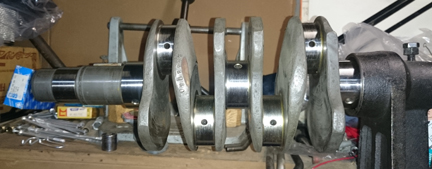 There
was no particular crankshaft that came with this crankcase so the one at right
has been provided. It's an "SC/912".
There
was no particular crankshaft that came with this crankcase so the one at right
has been provided. It's an "SC/912".
AT RIGHT: This crankshaft had formerly been re-ground and afterward protected with a coating of grease which dried on it. As we no longer have true solvents to use in cleaning, you can see a little of the remnants of the dried grease that was too stubborn to be wiped away - it'll dissolve in the oil used in assembly. Note that the gears are not yet mounted in this photograph.
AT RIGHT: To this were fitted appropraite rods, rebuilt as usual: Late type, the best ever made.
For me, "rebuilding the rods" means to:
This is all standard work so there aren't any photos of them in-process.
AT RIGHT:Crankshaft with rods. Note that these rods were remarkably well balanced as a set from new. Also remarkable is that Porsche used several manufacturers and for whatever reason most "sets" were mixed from different vendors and even different tooling from the same manufacturers, but these are all the same.
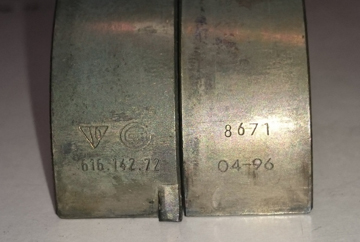
AT LEFT: I don't usually bother to photograph rod bearings, but these are actually genuine Porsche rod bearings - not something seen too often today - so, here you go!
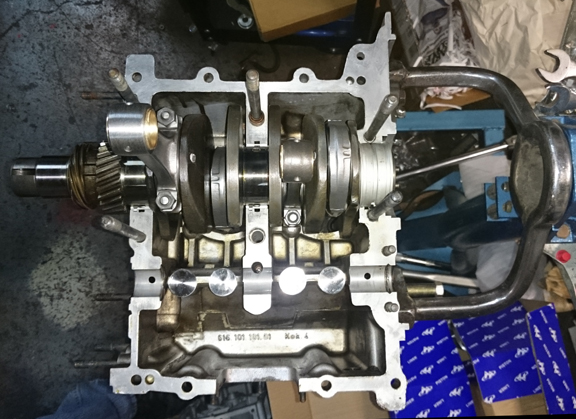 Crankcase
Assembly
Crankcase
AssemblyBy the time we get here, the case has already gone through cleaning and whatever machine work it may need, so here we should be ready to just assemble it all!
This usually goes pretty quickly - if all the previous tasks were performed correctly.
AT RIGHT: The left case half now ready for assembly, withbearing shells and lifters installed. Note that the lifters have been refaced - never assemble an engine without refaced (or new) lifters!
At this point, one merely confirms most of what one thinks oneknows about the assembly and then fits a cam and its gear.
I don't usually show the main bearings, but the ones fitted are the new "steel backed" ones provided by Stoddard (Porsche dealership).
BELOW: While assembling this engine, I happened to notice that there were two types of the same type lifter! What?! Take a look in this image of the back-side of the lifter heads of the two versions of the same type lifter. Take a note, one side has the "Ate" logo and 3900 designation upside down as compared with the other one! Both were part of the same original set!
The camshaft is an old-school 1600S cam which someone reground for a bit more lift. It had no visible flaws, so, we went with it.
The next step was to find a gear for the camshaft. They're sized of larger or smaller than a standard just called "zero." The range of available gears back in the day was maybe +3 to -3 from Porsche (or VW) and perhaps as big as +5 and small as -5 from aftermarket sources.
Today you're lucky if you can find any! However, over 30 years ago now I bought up a stash of twenty or so new gears to add to my small stash. Generally one comes in when another goes out, but occasionally a new one or so gets added. So, there is some modest churn in the stock. But what I have learned is that the gears weren't consistently marked between vendors, so one vendors +1 might be another vendor's -2. Strange but that's how it is. So, you have to constantly pick through gears as a trial-and-error process rather than just grabbing the next size over. Another fact is that for some reason, every engine seems to need a negative 1 or smaller. So, all the really small gears get picked over and all that's left are larger ones.
AT RIGHT: The box of properly sorted cam gears as discussed in the text, ranked by size (paper tags).
This makes it crazy-hard to quickly select a cam gear that fits. So, a year or so ago, I contracted a gear company to take my stash of some 25 or so units and rank them by size and then trim the really big ones to fill in the gaps on the small end of the scale. So, in this instance, I found the right gear on the second try! The first one had no lash, so I went two smaller and PERFECTION! I like it when that happens!
With the cam selected, gear fit, now time to put the case halves together! (Note the other case half was waiting and an image of it is found above in the crankcase preparation section.)
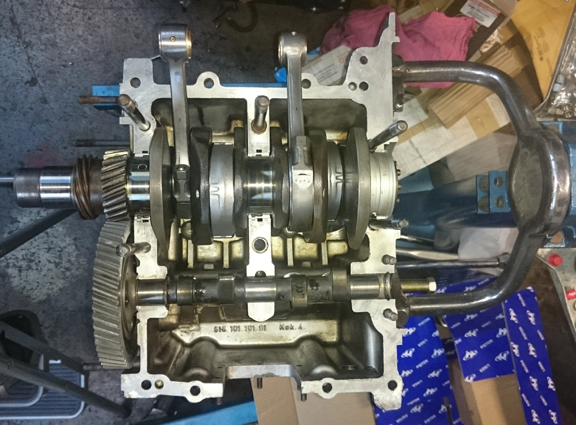
Regretably, photos of the camshaft end and gear were too fuzzy for use. But you can see them mated up here.
Assembly of the two halves then goes rather quickly and the result is a "bottom end," sometimes called a "short block" - sometimes a short block doesn't include the timing cover, sometimes it does!
In this instance, once we knew which main bearings were being fitted, we installed the new nose bearing into the timing cover. Unfortunately, we forgot to take images of that process. However, our strategy was to set up our special jig that catches the bearing from falling through, and set the cover to warming in our workshop oven, while having had the bearing in the freezer for a long period. We then pulled the cover out of the oven, set it on our special jig, and then dropped the frozen bearing into its bore. Perfect job!
Again, the two main case halves can be seen above in the crankcase preparation section. Once the two halves were bolted together, in delight, we quickly added the oil-control-piston bypass tube to the third piece, inserted the three tubing-like seals that permit oil flow from the timing cover to main halves, installed the o-ring for the oil pickup tube, slid on the paper gasket and installed the timing cover. It took all of 3 minutes, maybe! And, we forgot to take photos of it just before installing the cover! However, we did take this gem immediately following:
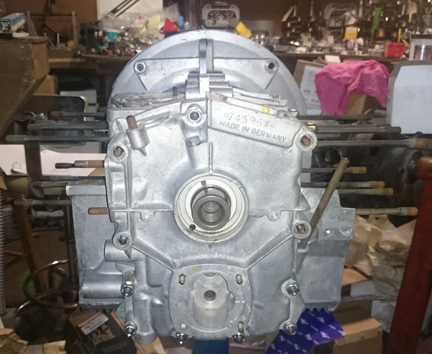
AT RIGHT: Here, the timing cover has just been installed. It, too was carefully inspected and cleaned. The sharp reader will notice the nose bearing retaining bolt has also been plated. And, the black spot on bearing #4 was used to align the bearing with the retaining bolt during bearing installation.
The engine is now, ready for the next stage; conversion from short-block into a long-block!
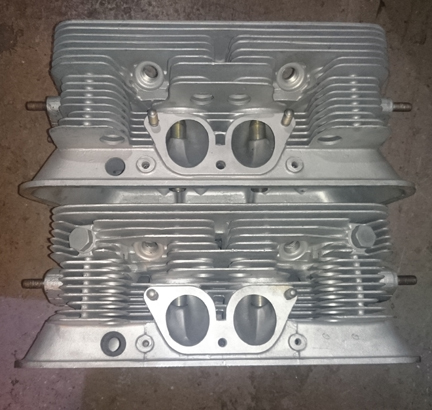 These
heads are not a matched pair. One is period correct for the case, and the other
is from a younger 912 - a perfectly fine replacement - and both are in great
condition! They've never been cracked, still have their original seats. And,
they have just had brand new valve guides installed.
These
heads are not a matched pair. One is period correct for the case, and the other
is from a younger 912 - a perfectly fine replacement - and both are in great
condition! They've never been cracked, still have their original seats. And,
they have just had brand new valve guides installed.
AT RIGHT: Note that all the fins and studs are in fine condition. All threads have been checked and ensured they're ready for service. The upper head is the period-correct one to match the case. The lower head is the next younger version - a perfectly suitable replacement. Notice the bolts serving as plugs to close off the ill-concenved air-injection ports which were an early attempt at smog control.
Every engine gets all new valve guides and either new or refaced valves.
Fitted to these heads are great valves. They're originals, not aftermarket replacement which are all you can get new today. Unfortunately, the exhaust valves are not the sodium filled type, which haven't been available new for some years now. Of course, the valves have been checked for length (stretching makes them unworthy), polished, and refaced, so they're effectively perfect.
New springs, of course, carefully selected.
Every few months, we go through a large batch of about 40 new springs and group them by strength. First we match into groups of eight, then, with each group of eight, we match up slightly stiffer springs with the heavier valves (intakes are about 2% heavier than exhausts), so they're very close sets, matched up, so all the valves tend to float at the same time. ...Of course, each valve and retainer are position-specific through the shimming process...
Below: The only damage on either head can be seen in the image on the left below, on the upper left combustion chamber. Apparently something got loose inside the chamber, but the damage wasn't bad, just a few dings. Otherwise, these heads are great!
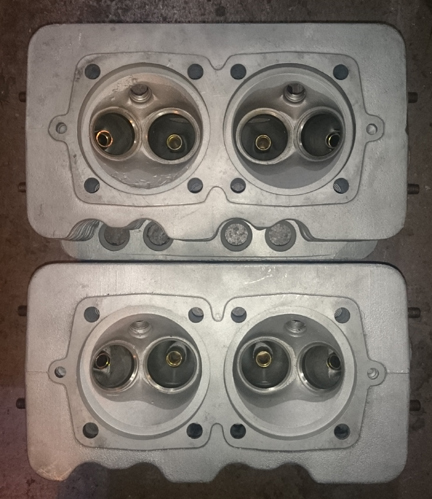
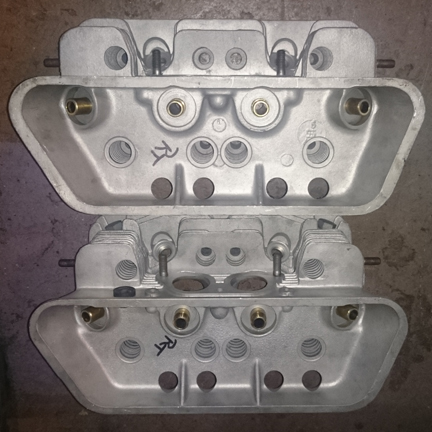

AT RIGHT: The valves in this engine, cleaned, inspected, refaced, and stems polished, ready for assembly.
The springs can be seen in the images during full assembly. They are stronger than stock because we have, as a community, learned that the stock springs were weak enough that sometimes an engine might over-rev and a piston can strike an exhaust valve. I have had this happen to me, personally, on a completely stock SC engine way back in the 1980s, so, by now, all knowledgeable engine builders use stiffer springs to avoid this problem.
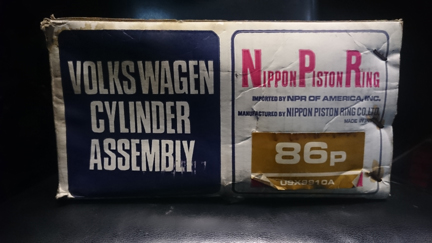 Pistons
and Cylinders
Pistons
and CylindersWe selected for this engine a set of NIB "NPR" cylinders. (Yes, the box says Volkswagen, but the 86p gives it away.) These are the last of the breed - or, well, we have one more box on the shelf! The NPRs were go-to set for many decades and were always a big-bore solution at 86mm (as opposed to the stock bore of 82.5mm).
Of course, I weighed them up and balanced them. Including moving the piston pins around, and removing a little material, I got them to about 0.6g spread for the set, and it was Christmas Eve, so I just let it go at that. The stock weight spread is about 1.5 orders of magnitude heavier!
We always check the match pistons to cylinders and match piston weights as a set, and provide any remedial action to correct any errors before installation. Just because a part is new doesn't mean it's ready for service.
The next step was to measure the cylinder heights, sealing surface to sealing surface. Three were idential to within 0.001" - and yes, we use both inches and mm, depending on which is easier!
For many shops, from this point, installation goes very quickly, but we think this is where one needs to take one's time! The key reason one needs to take time here is that there are production tolerances on every part in an engine, and while a set of parts may look identical, there's often subtle variation between members of a set, and there are sometimes significant errors in production that weren't caught by the manufacturer's quality control processes. These errors can "stack up" and cause problems if not discovered and corrected.
Here's our process: Two of these steps require special tools most shops don't have.
BELOW: The cylinders were then trial-fit into their bores in the case and retained with special tools to measure the cylinder heights and ensure they match their neighbor. This is the CHC, and both sides are done.
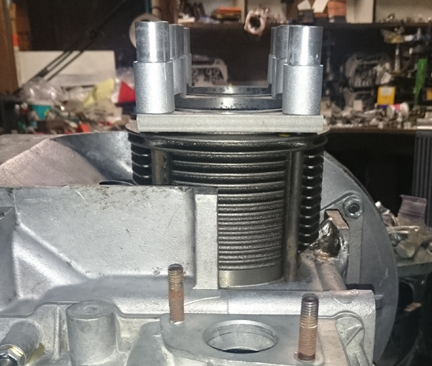
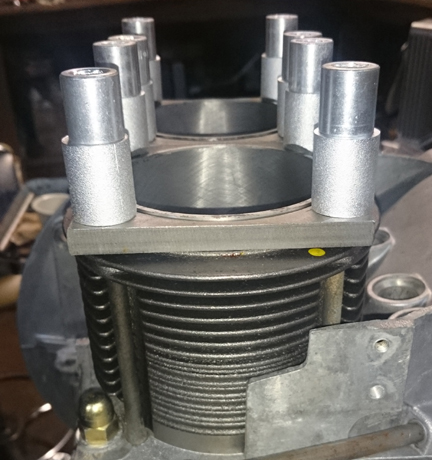
In this instance, the CHC showed the inside edge of cylinder 3 was 0.002" low - the tolerance is 0.004". The other side showed no deviation from being in a perfect plane.
BELOW: The pistons are fitted - without rings - and the CAC check is made (as described in the text above). A comparison of compression ratios of all four cylinders is then possible. Where necessary, the pistons (and even cylinders) can be moved around to find a better fit.

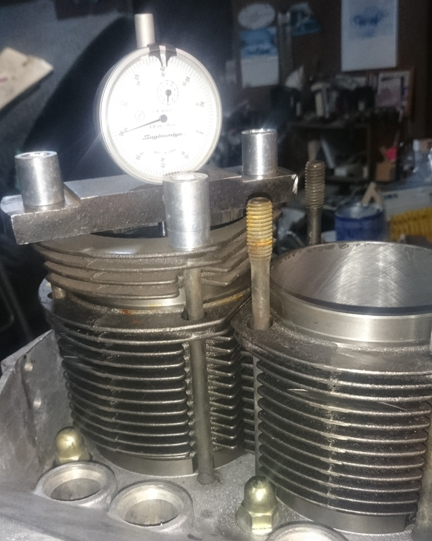
We like to carefully measure everything and then mix-and-match the parts for superior fit. We have also discovered significant manufacturing errors with this process which would likely have gone unnoticed without these measures. It is remarkably easy, for example, to overlook the circumstance of the crankshaft bore not in the true center of the crankcase, angled on the horizontal left or right of center, or not on the same horizontal plane at all. Yet examples of errors like these are not as uncommon as we would like.
The next thing we do is something nobody else does (that we know of) in the engine building process, and that is to measure the height the piston crown comes above the plane of the top of the cylinder. I call this the CAC, or "Crown Above Cylinder." This value is important because, firstly, it can reveal deeper problems, and because it helps us get the compression ratio equal in all four cylinders.
Here are some of the deeper problems that can be discovered through a CAC check:
In order to do this for these engines, you have to have special tools. Here, you can see them in action on this engine in the four images above.
The accuracy is so good, that if you take the time to swap parts around, you can accurately determine discrepancies in the manufacture of the various parts! But, we ARE splitting hairs here! However, a benefit to both engine builder and customer is that the ability to move parts around for better fit means that perfection is more easily achieved, and the more equal the HP production of each cylinder, the smoother the engine will run, and the more HP the engine will produce overall.
Because this process includes the entire assembly, torqued as in service, and measures the height each piston protrudes out of its cylinder, all errors in connecting rod lengths, cylinder heights, crankcase spigots depths (cylinder bore deck), piston connecting pin heights, and shim thickness' are accounted for in the measurement results. There is no superior method.
But, back to THIS engine... ...The older head's combustion chambers measured 62.7 ml while the younger one's measured 58.7 ml. The CAC values ranged from 3.3mm to 3.4mm. The subtle imperfections moved from one side to the other, coupled with asymetric cylinder shimming, lead to a near perfect 9.0:1 compression ratio in all four cylinders, with the whole set ranging less than 0.08 in varriation. (Anything better than about 0.15 is doing very well indeed!)
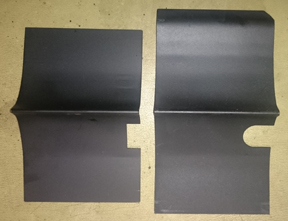 Final
Assembly of Longblock
Final
Assembly of LongblockAt this point the engine is ready for its cylinder heads, and this work went very quickly - as it should! - as all the prep work was already done.
AT RIGHT: A new pair of lower cylinder shrouds were fitted - after being repainted in barbecue black. Note the lines that are here horizontal on this web page - this shows that the reproductions, unlike the originals, weren't made in a press from dies. But, they work fine.
Prepare the head "bolts" and washers, prepare the pushrod tubes, prepare the lower cylinder air deflection plates and their wire retainers, and get the torque wrenches set, and bolt on those heads!
BELOW: (at left, the 3/4 side, on right are cyls 1 & 2.) On the right, note the stack of "head bolts" - nicely plated, ready for installation. Note also that the through-bolt, case-half nuts, and wire retainers for the lower cylinder shrouds are also plated - nothing was overlooked!
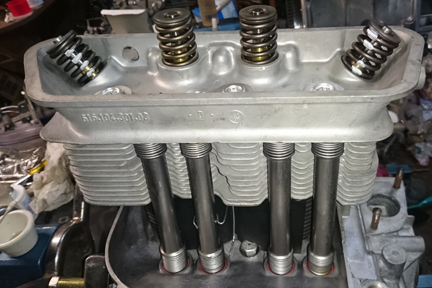
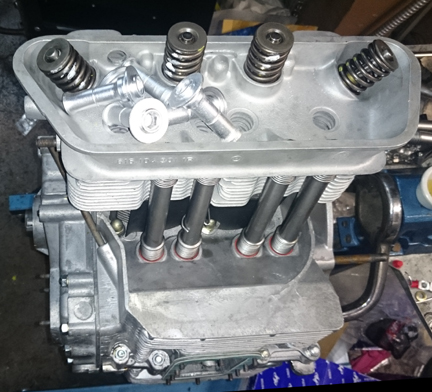
My pattern is to mount one head, torque it to 7 ft lbs, then mount the other head the same way, and then alternate between the heads with an ever-increasing torque up to the final torque value, then repeat the final value until the fasteners no longer turn when torque is applied.
OK, mount the valve gear, adjust the valves and pop on the valve covers. Looks like I didn't take any photos of the valve gear.
 Then
fit the oil drain plug, and sump screen and plate. Of some small note is that
all the sump studs are original and in fine condition. I used new cap-nuts to
protect the studs into the future.
Then
fit the oil drain plug, and sump screen and plate. Of some small note is that
all the sump studs are original and in fine condition. I used new cap-nuts to
protect the studs into the future.
Then, fit the two oil control pistons.
Can't forget the oil pump!
AT RIGHT: Here, just attending to some last minuted things going on underneath. Again, note all the fasteners are correctly plated. The sump plug and oil control pistons are both fitted, and non-stock but protective sump-stud nuts are fitted. These are not just VW items - which don't work - they are extra-deep to handle the longer sump studs used on 356 and 912 engines.
AT RIGHT: The writing on the oil cooler mounting area informs that the displacement is 1719cc, and the compression ratio has been set to 9:1. Here, we're only waiting for the valve gear to be mounted - and the rocker stands can be seen in the lower image, on the right, partially obscured by the right head. They weren't mounted yet because they hadn't been cleaned yet, though the rockers were ready.
By the way, this location, under the oil cooler, is a traditional place engine builders put markings like this, to inform those that follow without being obtrusive about it.
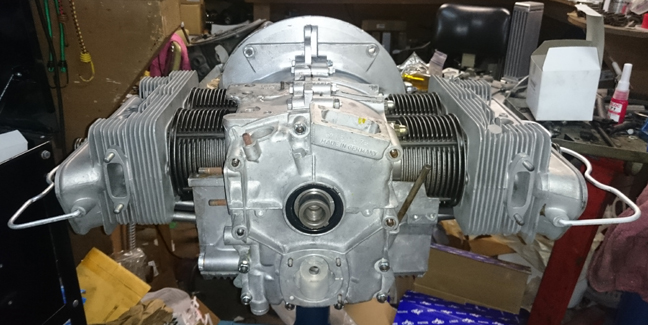
AT RIGHT: This engine, almost finished... Note the wire bails standing horizontally on their own: this is a little-known trick the factory suggests to know if the wire bails are going to hold the covers on tightly!
AT RIGHT: The oil pump gears have been mounted... The cover can be seen mounted, too, in photos up at the top.
BELOW LEFT: In this closeup of the rockers, you can see that the tips which ride against the valve stems have been not just refaced but a new layer of metal has been added to help reduce wear. In the original, it was only surface hardened, and once worn through, the rockers won't keep adjustment - and keep shedding particles into the oil! However, this "hard-face" material is stronger than the original surface and is considered a permanent solution.
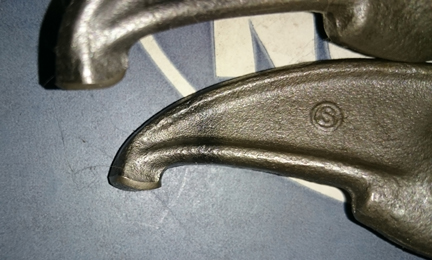
Do notice that all the rockers and their shafts, cleaned, hard-faced, re-surfaced, and shafts polished, are visible in an image up in the "purchase options" area almost at the top of this page!
The pushrods are up there, too!
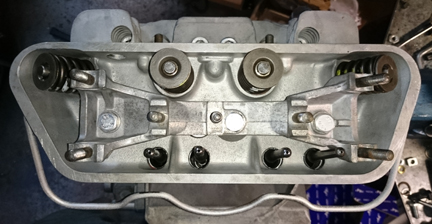
At this point, it's practically done - a simple valve adjustment, pop on the valve covers, and it's done!
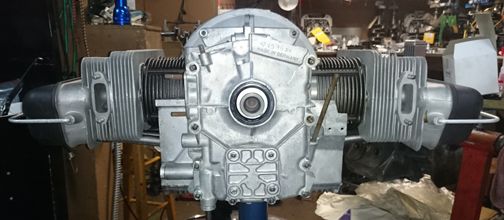
As noted above, this is the default type flywheel that'll be fitted, ready for service. There are lots of options - listed way up near the top; this is the one you get if you don't chose something else. Due to all the options available, and our history of guessing wrong, we do not supply a pressure plate! A pressure plate should be balanced with whatever flywheel you run! Don't run a pressure plate that hasn't been balanced to your specific flywheel!
BELOW: This 912 flywheel has been surfaced and balanced very accurately. Note that three surfaces have been machined - this is doing it correctly.
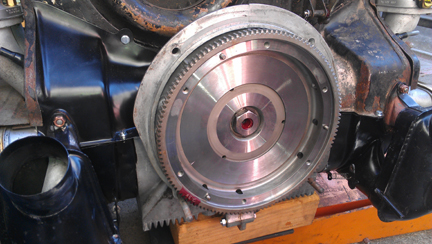
Because some people are keeping logs of VIN and engine numbers and then purport to tell people what someone else has, out of respect and concern for a buyer's privacy, exact VIN and engine number data are not published here.